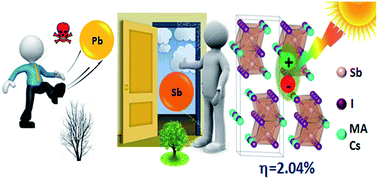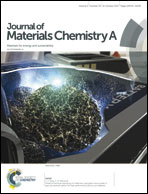Solution-processable antimony-based light-absorbing materials beyond lead halide perovskites†
Abstract
Organic–inorganic lead halide perovskites have recently emerged as highly competitive light absorbing materials for low cost solution-processable photovoltaic devices. With the high efficiency already achieved, removing the toxicity, i.e., lead-free and stability are the key obstacles for perovskite solar cells. Here, we report the synthesis of an antimony (Sb)-based hybrid material having the composition of A3Sb2I9 [A = CH3NH3 (MA), Cs] and an investigation of its potential photovoltaic applications. Sb-based perovskite-like materials exhibited attractive absorbance properties, with the band gaps of MA3Sb2I9 and Cs3Sb2I9 measured to be 1.95 and 2.0 eV, respectively. X-ray photoelectron spectroscopy confirmed the formation of stoichiometric perovskites from appropriate precursor molar ratios incorporated with hydroiodic acid (HI). Planar hybrid Sb-based solar cells exhibited negligible hysteresis and reproducible power output under working conditions. A power conversion efficiency of 2.04% was achieved by the MA3Sb2I9 perovskite-based device—the highest reported to date for a Sb-based perovskite solar cell.



 Please wait while we load your content...
Please wait while we load your content...